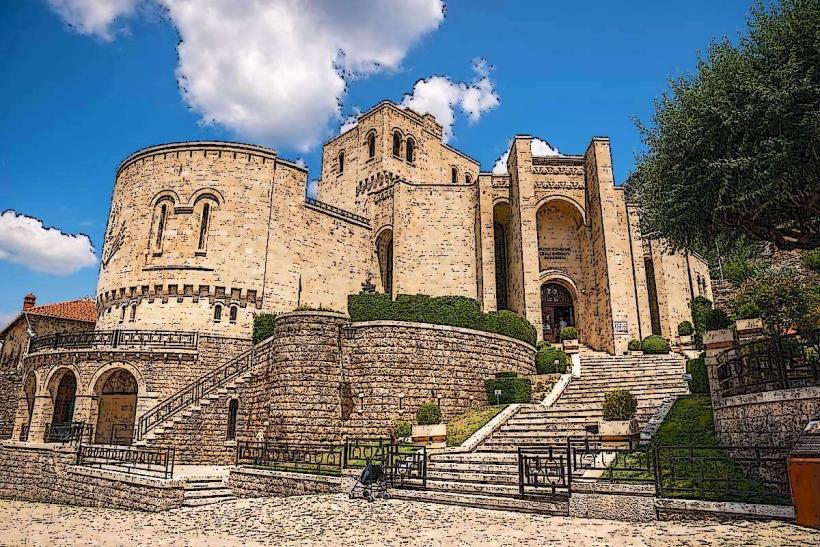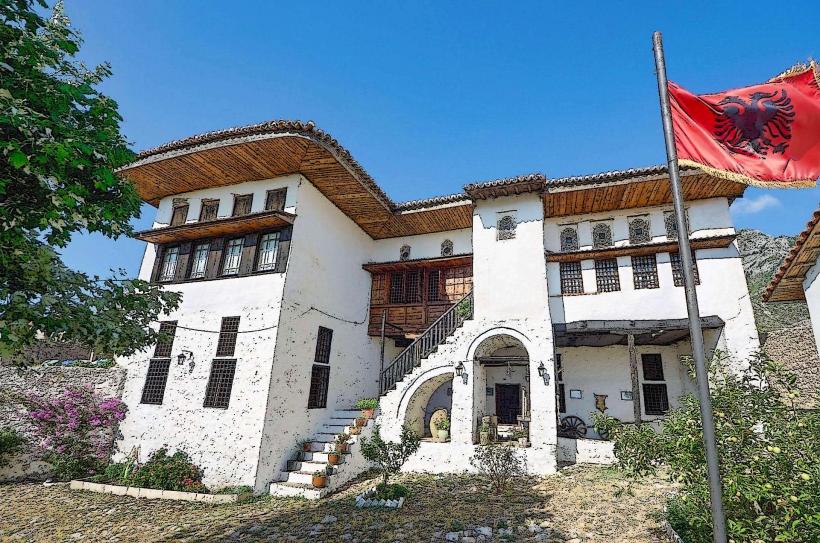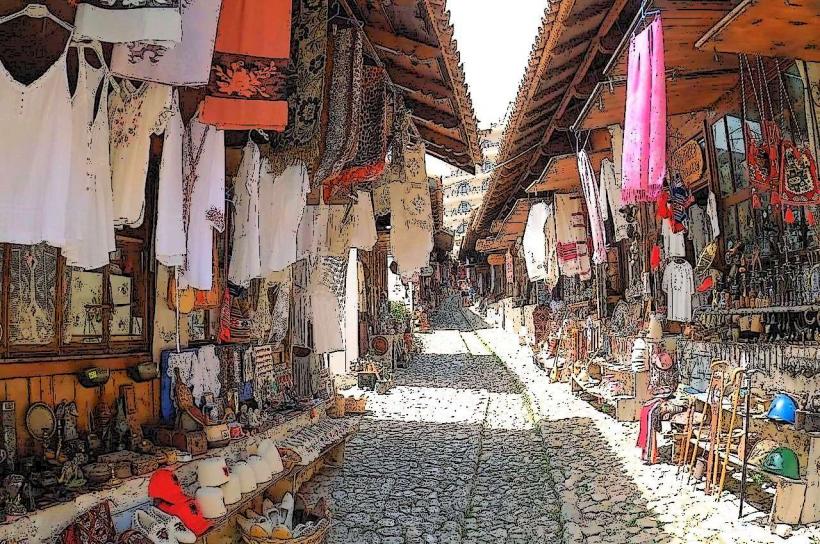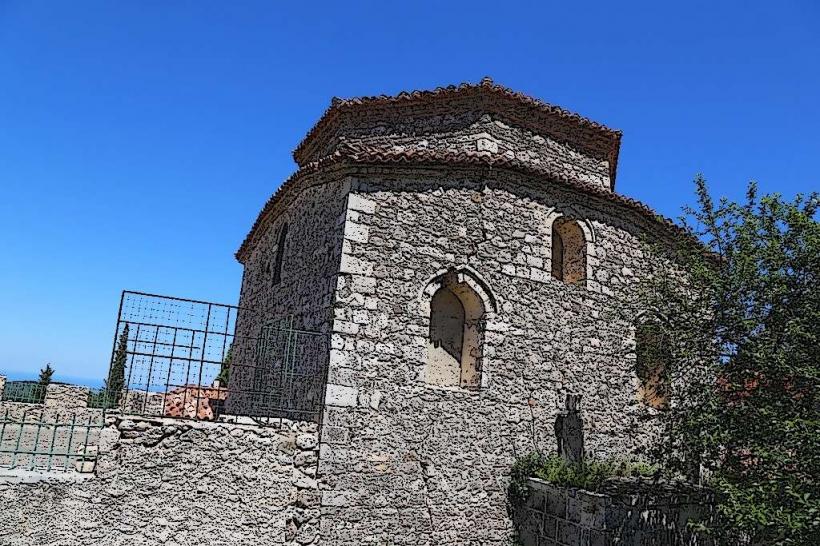Information
Landmark: Skanderbeg MuseumCity: Kruje
Country: Albania
Continent: Europe
The Skanderbeg Museum (Muzeu Skënderbeu) is one of the most significant cultural institutions in Krujë, Albania, dedicated to the life and legacy of Gjergj Kastrioti, better known as Skanderbeg. Skanderbeg is revered as a national hero of Albania for his resistance against the Ottoman Empire during the 15th century. The museum is located within Krujë Castle, which was the stronghold of Skanderbeg during his campaigns and remains a symbol of Albanian independence and national pride.
History and Significance of the Museum
Dedication to Skanderbeg:
- The Skanderbeg Museum was established to honor the life and achievements of Gjergj Kastrioti (Skanderbeg), who led the Albanian resistance against the Ottoman Empire from 1443 to 1468. Skanderbeg's efforts are considered pivotal in preserving Albanian territories and identity during a time when much of the Balkans was falling under Ottoman rule.
- The museum highlights Skanderbeg's strategic brilliance, his alliances with European powers, and his heroic defense of his homeland. His resistance became a symbol of the fight for freedom against foreign oppression.
Skanderbeg's Legacy:
- Skanderbeg's legacy is deeply ingrained in Albanian national consciousness, and the museum serves as a reminder of the historical struggle for independence. His role in defending Albanian territories, especially Krujë Castle, against the Ottomans for nearly 25 years, marks him as one of the greatest military leaders in Albanian history.
- The museum also celebrates the cultural heritage of the Kastrioti family, from which Skanderbeg came, and provides insight into the medieval history of Albania.
Museum Features and Exhibits
Exhibits on Skanderbeg’s Life and Military Campaigns:
- The Skanderbeg Museum features a wide range of exhibits that chronicle Skanderbeg’s life, military campaigns, and leadership. The museum houses manuscripts, documents, and maps that document his activities during the resistance.
- Visitors can view paintings of Skanderbeg and depictions of his famous battles, as well as learn about his tactics and alliances with other European powers, such as the Papal States, Naples, and Venice.
- There are also artifacts such as weapons, armor, and coins from the time of Skanderbeg’s resistance, giving visitors a tangible connection to the period.
Skanderbeg’s Early Life:
- The museum also covers the early life of Skanderbeg, including his birth into the noble Kastrioti family in the town of Svetigrad (modern-day Albania), his time spent as a hostage in the Ottoman court, and his eventual rise as a military leader.
- The exhibits provide context about the political and military situation of the time, including the rise of the Ottoman Empire and the strategic importance of Skanderbeg’s efforts to keep Albanian lands free.
Visual and Audio Displays:
- The museum includes various visual displays, such as reproductions of important historical documents, battle maps, and portraits of Skanderbeg, which help visitors understand the scope of his struggle.
- There are also audio-visual installations that recount the key events of his resistance, offering a more immersive experience for visitors.
Artifacts and Historical Objects:
- The museum showcases a variety of medieval armor, weapons, flags, and other relics from the time of Skanderbeg’s campaigns.
- One of the most iconic items in the museum is a helmet thought to have belonged to Skanderbeg himself, though its authenticity is debated among historians.
Skanderbeg's Symbolism:
- The museum also emphasizes how Skanderbeg became a symbol of Albanian unity and the fight for independence. His coat of arms, a double-headed eagle, became the symbol of Albania and is prominently displayed throughout the museum. It represents the unity of the Albanian people and their resistance against foreign oppression.
The Museum Building and Location
Situated in Krujë Castle:
- The Skanderbeg Museum is housed in the Royal Palace within Krujë Castle, which adds to the authenticity of the experience. The castle itself was the site of many of Skanderbeg's important military activities and served as his base of operations during his struggle against the Ottomans.
- The museum is located in a historical structure, which allows visitors to connect directly with the history of Skanderbeg, as they walk the same grounds where he once stood.
The Castle's Role:
- Krujë Castle is one of the most important landmarks in Albania, and the museum's location within it enhances its significance. The castle’s strategic location atop a hill gives visitors a panoramic view of the surrounding valley, offering insight into the military advantage Skanderbeg had in his defense of the castle.
- Visitors can explore the castle grounds, which include other attractions like the Ethnological Museum and the Church of St. George, further enriching the historical experience.
Visiting the Museum
Opening Hours:
- The Skanderbeg Museum is typically open every day, with operating hours generally from 9:00 AM to 7:00 PM during the tourist season (April to October). However, it is advisable to check the museum's hours before visiting, as they may vary during off-peak seasons.
Entrance Fee:
- There is an entrance fee to visit the Skanderbeg Museum and the castle. The fee typically covers access to the castle grounds and other attractions in the area.
Guided Tours:
- Guided tours are available in several languages, including English, and provide detailed explanations of the exhibits and the historical significance of Skanderbeg and Krujë Castle. These tours can enhance the visitor experience and provide deeper insights into the life of Skanderbeg and the history of the region.
Best Time to Visit
The best time to visit the Skanderbeg Museum and Krujë Castle is during the spring (April to June) or fall (September to October), when the weather is mild, and the crowds are smaller. Summer (July and August) can be more crowded, especially with tourists, but it’s still a great time to visit if you want to experience the vibrant atmosphere of the castle and its surroundings.
Krujë is a popular day trip destination from Tirana, making it a great place for those interested in history, culture, and the heritage of Albania.
Conclusion
The Skanderbeg Museum is a must-visit destination for those interested in the history of Albania and its fight for independence. It provides a fascinating look into the life of Skanderbeg, one of the most iconic figures in Albanian history, and offers a unique opportunity to explore the Krujë Castle, a symbol of Albanian resistance. Whether you're a history enthusiast or simply interested in learning more about Albania’s past, the museum offers a rich and immersive experience that is both educational and inspiring.





